Recently, Li Ning announced a joint activity with Bored Ape Yacht Club (Bored Ape Yacht Club) #4102 NFT through the official account of the social platform.

(Screenshot of Li Ning's official Weibo)
Li-Ning will launch clothing with this NFT image, #4102 Boring Ape will also serve as the manager of the pop-up store of Li-Ning's "Boring is not boring" in China. Previously, Adidas also photographed the boring ape number #8774, and used this image as one of its signatures in its own NFT project.
In an environment where domestic alliance chain NFT has basically become a trend and supervision is gradually tightened, can Li Ning publicly use BAYC (boring ape) public chain NFT for joint marketing?What is the legal basis for the corresponding action and is it contrary to current laws, regulations or regulations?
PART1:
Authorization basis: CC0 mechanism
Li Ning directly applied the purchased "Boring Ape" NFT image in product printing and materials (some people in the industry pointed out that Li Ning launched a marketing campaign after directly purchasing BAYC#4102), the important reason is that "Boring Ape" has given Unlimited authorization for adaptation, reproduction, distribution, etc. This involves the CC0 authorization mechanism related to it.
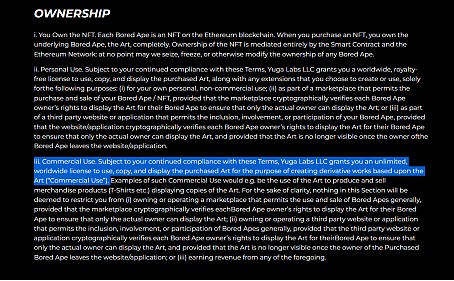
(Part of the Bored Ape Agreement: https://boredapeyachtclub.com/#/terms)
(1) CC0: "Let Possession Be All" According to existing laws, whether artists care about copyright or not, copyright law will default to copyright protection for works of art. If the creator labels the work with "CC0", it is basically regarded as giving up the property rights in the legal sense.

(Related description of CC0 license: https://creativecommons.org/licenses/)
This allows NFT holders to carry out commercial use such as secondary creation of works, and binds the concept of "owners of NFT enjoy copyright license" with the corresponding NFT. It embodies "no rights reserved", which is clearly different from the disclaimer clause "all rights reserved" adopted by domestic mainstream data collection platforms.
(2) Smart contract empowerment, business does not need "white lotus" Regardless of the issuer or the holder, the commercial demand for the explosion of NFT is the same. Therefore, under the "creator share system" contract, the arrival of the CC0 model is actually a matter of course.
1. Seller's Perspective
The popularity of the CC0 model is inseparable from the creator sharing mechanism in the smart contract. If the NFT smart contract allows the creator to draw a commission in each NFT transaction, then in order to maximize the benefits, the creator tends to add more empowerment to the NFT - the full transfer of the property intellectual property rights of the digital original, It will undoubtedly be a key link.
2. Buyer's Perspective
From the perspective of consumers, after understanding the essence of NFT technology, they often disdain to get only a "white lotus" picture that can be seen from a distance but not played with after buying at a high price. The general license (preferably exclusive license) of property rights such as the right to adapt pictures is the basis for the commercial realization of works (especially art works), and is naturally the basis for the buyer to pay.

(Derivatives development based on CC0 mechanism)
It can be seen that allowing NFT holders to develop and use corresponding digital components without any worries is actually a consensus of interests between buyers and sellers , which meets the inherent needs of safe use, and is a manifestation of the basic philosophy of the Web3 era.
PART2:
Regulatory Feasibility: "Old wine in new pots"
In layman's terms, Li Ning just used the new authorization mechanism of Boring Ape NFT to carry out the traditional IP co-branding behavior, which is the so-called "old wine in new pots" . During the whole process, blockchain technology has always been in a supporting neutral position.
(1) Public chain Although Boring Ape is a public chain NFT, this joint activity is purely an off-chain activity. The blockchain filing mechanism is actually to meet the regulatory needs. The country’s cautious attitude towards public chains stems from the regulatory difficulties brought about by the absolute decentralization mechanism of public chains, but it does not mean a direct denial of blockchain public chain technology.
Therefore, regardless of whether the NFT originates from the public chain or the alliance chain, if it is onlyused for offline joint use and does not go up the chain again, such activities will not fall within the scope of the blockchain red line.
(2) Hype and financial containment Hype prevention focuses on the rationality of NFT pricing and selling prices, while financial containment focuses on NFT empowerment and sale specifications, both of which take NFT itself as the direct target.
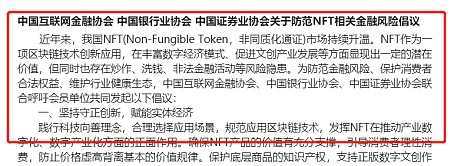
(Industry initiative on NFT financial risk prevention)
This time, Li Ning only adapted and co-branded the Boring Ape digital components after the release, and the corresponding publicity and sales actions acted on the picture itself, not only did not involve financial attributes, even the actual technical side was not directly involved.
PART3:
Risk analysis and legal advice
The joint name of Li Ning and Boring Ape is undoubtedly a successful trial under the current blockchain supervision background. After the administrative supervision risks have been largely eliminated, some customers have consulted on the feasibility of co-branding a well-known domestic NFT-IP. In this regard, we make brief legal advice from the perspective of the buyer (joint party):
(1) Authorization restrictions IP co-branding naturally needs to be used commercially, which will involve at least three items: adaptation rights, reproduction rights, and information network dissemination rights . If the NFT issuer chooses to retain the intellectual property rights of the NFT, the NFT holder has no right to commercialize the NFT use.
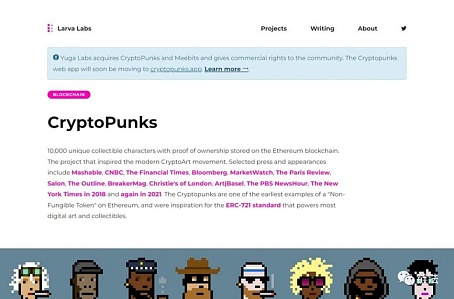
(For example, Larva Labs reserves the relevant intellectual property rights to the CryptoPunks series of NFTs)
Suggestions for this:
1. When the buyer chooses a joint NFT, he must consider the content of the intellectual property authorization. He should at least guarantee the authorization of the three rights of adaptation rights, reproduction rights, and information network dissemination rights , not only at the personal level, but also at the commercial level. level of permission;
2. For the authorization model, it is recommended to give priority to exclusiveauthorization of NFT, or NFT whose author has declared to waive intellectual property rights , so as to avoid confusion between NFT authorization and author's offline authorization to third parties;
3. Some NFTs will be restricted in terms of commercial use benefits when they are sold. Although holders enjoy commercial use rights, they are only based on certain commercial benefits (for example, they can only be used in commercial activities worth $100,000) , at this time, the buyer needs to evaluate the scale of commercial use first ;
4. It should be noted that if NFTs are produced in batches, and similar NFTs are difficult to form significant differences in style, the use of adaptation rights for such NFTs may cause rights conflicts .
(2) Issue of invalid authorization NFT is an on-chain technology. Whether the person and author of the digital element are the same, or whether the two parties have reached an agreement on the scope of authorization will directly determine the validity and scope of NFT authorization. If the publisher is not the author himself, all authorizations of the publisher for NFT are only valid after the author's permission or ratification.
Suggestions for this:
1. The buyer should conduct necessary investigations on the ownership of the corresponding digital components when purchasing NFT, such as requesting to provide author creation materials, copyright registration materials, digital component uplink records, etc., to determine the ownership of digital components;
2. In view of the anonymity of the blockchain, the authors of digital components often do not clarify their true identities. Therefore, in the case of inconsistencies between the issuer and the creator, the platform needs to further review the real identity of the author of the digital components to ensure that there is no authorization disputes, while avoiding the dilemma of no one to sue when a dispute arises;
3. Authorization regional review , intellectual property protection has geographical restrictions, the buyer needs to pay attention to whether the joint project is included in the scope of authorization (that is, pay attention to whether the NFT has given a global use authorization or a specific use authorization).
(3) Authorization confusion Many domestic NFTs will adopt the authorization mechanism of "one thing with multiple issues" . In this case, the CC0 mechanism is attached. As the number of NFT holders increases, there will be authorization confusion. Whether it is publicity or propaganda, conflicts of rights are likely to occur.
Suggestions for this:
1. There is a certain conflict between the CC0 mechanism and the "one thing, one issue" issuance model, and buyers can give priority to the use of "one item, one issue" NFT;
2. Under the one-thing-multiple-issue mechanism, if the scope of NFT authorization cannot be effectively restricted, consider purchasing all of the NFT to ensure the exclusivity of the authorization.
(4) Trademark squatting and rights protection Most "blue-chip NFTs" abroad may have been preemptively registered as trademarks in China , which will cause malicious restrictions on the commercial use of NFT obligees, such as restrictions on publicity and promotion. At this time, even if the buyer enjoys the commercial use rights of digital components, he still needs to pay the necessary time cost for rights protection, and even the cost of business opportunities.
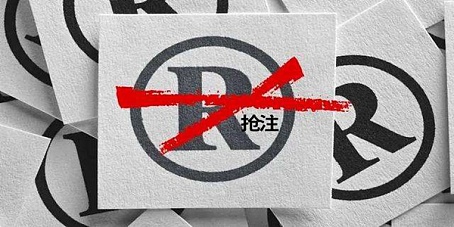
(The picture comes from the Internet)
Suggestions for this:
1. Review the trademark registration status of NFT digital components;
2. Priority is given to NFTs that give the holder the right to sue (the original author waives the copyright model, and the holder is authorized to sue on his own), so that he can protect his rights as the holder himself in the event of infringement or unfair competition;
3. After purchasing NFT, based on the scale and purpose of commercial development, register the copyright of the digital original and apply for corresponding trademark protection.
write at the end
NFT is not just a simple Right click and a JPG format composed of random elements . The most important thing is its own brand awareness and the community consensus built, especially the sense of atmosphere in it, which is also web3. 0 De-centralization features, consensus cohesion.
Correspondingly, under the introduction of the CC0 mechanism, NFT uses intellectual property rights as the basis of its commercial value, which will give it a reasonable basis for pricing and selling prices .
Author of this article: Liu Shenfan Kenting Metaverse Team
 Zoey
Zoey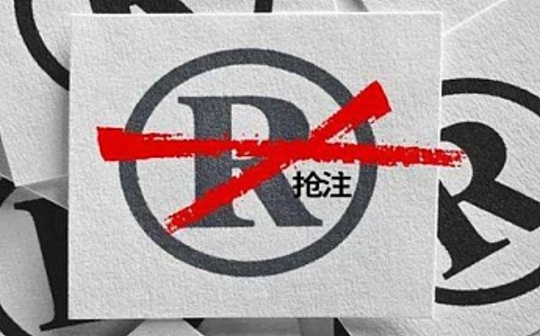
 Zoey
Zoey Davin
Davin Beincrypto
Beincrypto Bitcoinist
Bitcoinist Others
Others Beincrypto
Beincrypto Bitcoinist
Bitcoinist Bitcoinist
Bitcoinist Cointelegraph
Cointelegraph Cointelegraph
Cointelegraph